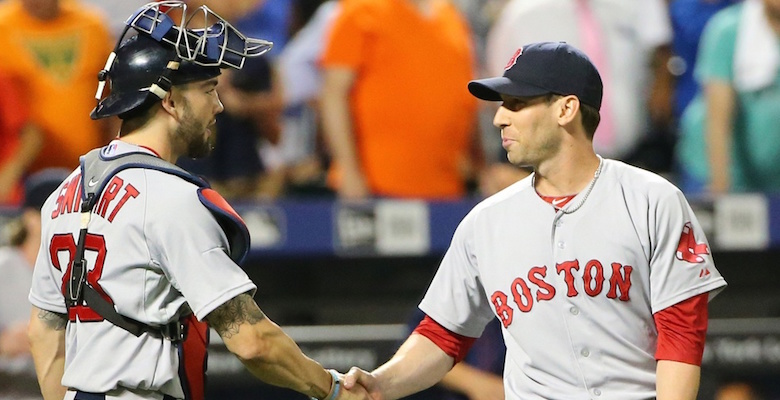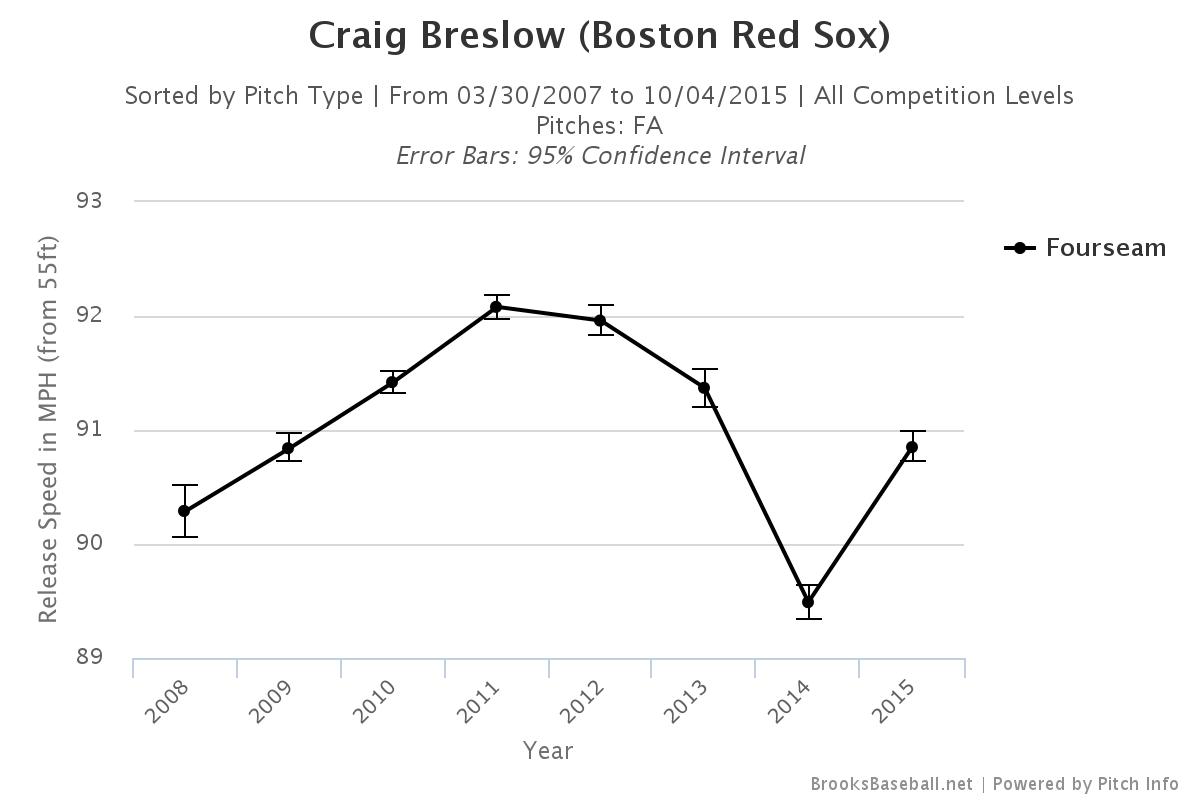At 35 years young, Craig Breslow was pressed into duty in the starting rotation this September after plying his trade for years in the bullpen. Perhaps “pressed into duty” is a bit misleading — Breslow made just two starts — but he was able to prepare as a starter for a few weeks, and in the final days of a lost season, that qualifies as noteworthy.
As is the case with a lot of fringy lefties who at least flirt with 90 mph, Breslow has been used as a matchups guy for some time, with somewhat limited success. He was quite good in 2013, quite bad in 2014 and somewhat less bad in 2015, including his surprisingly decent showing in his two “starts” as the lead man in “bullpen days” designed to save the arms of Eduardo Rodriguez, Henry Owens and others. It may seem far-fetched, but has Breslow pulled a Rich Hill and improved his impending free-agent outlook through his two decent outings?
Here, the answer is yes and no because it depends on which southpaw we’re talking about. Hill probably has changed his market, in that he might not have had one, and now he probably does. But that’s the thing about having one unhittable pitch that, even when throwing it more than a third of the time, hasn’t seemed to get more hittable. There’s a ceiling there, maybe, that just hasn’t been reached before. It’s hard to throw a changeup more than 20% or 25% of the time, but Hill’s curve hasn’t necessarily been about deception (well, maybe in one way). And there’s the small matter of finishing four starts with a Deserved Run Average of 1.50.
Breslow may not have the same shadow of unreached ceiling following him around, and he doesn’t have the same recent history of success. Breslow finished the year with a 4.15 ERA, possibly with more than a little luck, as he’s also finished with a 4.95 DRA. Not nearly as bad as his 2014 (5.96 ERA, 6.80 DRA), far and away his worst season in MLB, but not necessarily a guy for whom you work hard to find space on your roster. I’m not sure what replacement level is for a bullpen lefty who averages well over an inning per outing, but we can take his -0.2 WARP this season as an indication that it’s not too far away from the somewhat-improved Breslow of 2015.
In this second, longer go-round with the team, Breslow has gotten by throwing his four-seam a lot less, mixing in a sinker, cutter, and curve a whole lot more.
As for his quasi-rebound this season, we probably don’t have too far to look. In this second, longer go-round with the team, Breslow has gotten by throwing his four-seam a lot less, mixing in a sinker, cutter, and curve a whole lot more. But although opponents had their highest slugging percentage against his four-seam in 2015, it may have been a more helpful part of his repertoire this year with more of a velocity difference between it and his other pitches. His four-seam velocity did take a step back toward the range that he held while he was so successful from 2009 through 2013:
With only two career starts to his name, a sparkling 1.93 ERA in 9.1 innings of work in these last two outings at least raises some questions. Considering he wasn’t really in a matchups role anyway, has Breslow been miscast as a reliever? It’s not like a swarm of scouts had all pegged him for that role at the outset of his professional career; Breslow was a 26th rounder for the Brewers in 2002, and after his release in 2004 out of Single-A ball, he was picked up by the Padres out of a tryout camp. And while we always have to be careful with relievers who may have been kept away from the most difficult competition when hitters would have the platoon advantage, over his (fairly lengthy) career, right-handed hitters have hit just .238 against him to lefties’ .240 average, although he’s walked righties at a slightly higher clip.
For his part, Breslow offered at least two reasons for why his brief experience as a starter may have gone better. Here’s one: pitching out of the windup, Breslow felt like he had a “better rhythm.” He has often entered the game with a runner on, so that doesn’t sound like the craziest thing in the world. The problem? Breslow faced 141 batters this year with the bases empty, and 139 with at least one runner on; and it looks like Breslow was actually far better in the latter situation. Bases empty, Breslow had a 1.74 WHIP; with at least one runner, his 1.15 WHIP was as sterling as his earlier series of fine MLB seasons. That’s probably not it.
Breslow also suggested in the wake of his second strong start that the change in role helped him “keep hitters off-balance,” noting that it was common for him to have to go his “best pitch right away” when coming on with runners. Although Breslow has said that he gets in trouble when he thinks too much and starts to try to trick people, this is the same guy who calculated pitch spin by hand to help Josh Beckett win a bet before PITCHf/x was a thing. With the necessary small sample caveats, Breslow’s first pitch percentages from Brooks Baseball as a reliever and a starter this season:
| First Pitch Thrown | Four-seam | Sinker | Cutter | Curve | Slow Curve | Change |
| LHH, reliever | 35% | 20% | 31% | 10% | 0% | 4% |
| LHH, starter | 50% | 0% | 25% | 13% | 0% | 13% |
| RHH, reliever | 27% | 37% | 3% | 1% | 3% | 29% |
| RHH, starter | 39% | 11% | 11% | 0% | 11% | 29% |
Breslow did tweak his approach to forego all those first-pitch sinkers, but I’m not sure that comports with the idea that as a reliever he had to lead with his best pitch; opponents slugged .964 off of his sinker this year, and the weighted average slugging percentage on all of his other pitches combined was just .423.
In the end, what Craig Breslow has to teach us may be that we know nothing about this game, or that for two games, what we do know might not have a whole lot to do with the outcome. Did Breslow raise his stock with these two starts? Probably, but maybe not in a meaningful way. He did stick on the roster all year despite the closest thing to a pitching armageddon that we’ve seen at Fenway in a long while. But that may be exactly why we won’t see him return. One of Dave Dombrowski’s virtues may be impatience. And if you have to stock the staff with some replacement-level pitchers, you may be better off with pitchers who yet may be optioned — and actually replaced.
Photo by Anthony Gruppuso/USA Today Sports Images

